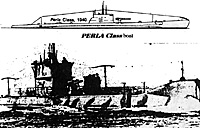
The Italian 'SUPERMARINA' lost its first submarine the same day Mussolini declared war on Britain and France - 10 June '40. The PERLA Class submarine GEMMA patrolling in the narrow channel between Sicily and Malta was torpedoed in error by one of their own SQUALO Class submarines, the TRICHECO. SQUALO Class boat
Admiral Sir Andrew Cunningham. CinC of the Allied Mediterranean Fleet whose main fleet, in accordance with the war plans, was based at Alexandria, Egypt with Malta, denuded of most naval vessels (including submarines) was determined to follow the traditional British naval policy of seeking out & destroying the enemy. Whilst the decision to leave Malta is difficult to criticize in the light of the German air efficiency, but it does reflect an over estimation of the Italian bombing prowess, as signified by the first raid on Malta.
Admiral Cunningham also knew that it was just a matter of time now before the arrival on the scene of the Luftwaffe, with their JUNKERS 87's - the STUKA, the only true dive bomber which could plummet vertically out of the sky to drop its 1,000 lb bombs with great accuracy; and the twin-engine JUNKERS 88 with its heavier bomb load; to attack the British fleet and neutralize Malta.
He was also confronted with another factor of crucial importance - the huge disparity between the two sides in submarine strength. The Italians possessed more than one hundred submarines; twice the number with which the Germans were wreaking havoc in the Atlantic and therefore might make penetration of the central Mediterranean an unacceptable hazard for British warships and especially for his ships to operate out of Malta.
At Gibraltar, under the command of Admiral Sir James Sommerville, was Force "H" formed around a nucleus of capital ships comprised of Sir James' flagship, the battle cruiser HMS HOOD; the battleships HMS VALIANT and HMS RESOLUTION; the aircraft carrier HMS ARK ROYAL; the light cruiser HMS ARETHUSA; and four destroyers.
The main object for the British Mediterranean Fleet had been laid down as the disruption on enemy seaborne communications, and this applied particularly to submarines. Now the pre-war parsimony in shelving the Malta submarine facilities was to be keenly felt; and felt with considerable bitterness as the war progressed.
There was little Admiral Sir Andrew Cunningham could do towards severing the Italian supply line from Italy to Tripoli, except perhaps send submarines back to Malta, which lay right on the flank of Mussolini's convoys to Africa. But Malta had virtually no air defence against bombing attacks from Sicily, and Admiral Cunningham had neither aircraft nor surface ships to spare for the defense of Malta. Anyway he decided to dispatch six submarines - HMS OSWALD, OSIRIS, PROTEUS, PHOENIX, GRAMPUS & ROVER to operate from Malta & attack Italian convoys.
The Royal Navy had a moral ascendancy over the Italian 'SUPERMARINA' and Admiral Cunningham right from the start, began to exploit it. At dawn on 11 June, he led the fleet to sea and swept the central Mediterranean as far as the approaches to Taranto, the main Italian Naval base on the instep of the boot of Italy and detached three destroyers to attack Italian submarines operating off the coast of Crete. Also, he sent cruisers to bombard Tobruk, a key port in Cyreniaca.
Patrolling off the harbor when the cruisers began their bombardment was the British submarine HMS PARTHIAN.
More Royal Navy
-
Submarines Sunk and the HMS Sealion
Mediterranean Campaign June 1940-July 1941
"T"- and "Porpoise"-Class Submarines
Malta
Italy Bombs Malta 1940
British Strategy Mediterranean 1940
British Parthian
Back to KTB #115 Table of Contents
Back to KTB List of Issues
Back to MagWeb Master Magazine List
© Copyright 1999 by Harry Cooper, Sharkhunters International, Inc.
This article appears in MagWeb (Magazine Web) on the Internet World Wide Web. Other military history articles and gaming articles are available at http://www.magweb.com
Sharkhunters International, Inc., PO Box 1539, Hernando, FL 34442, ph: 352-637-2917, fax: 352-637-6289, e-m: sharkhunters@hitter.net
